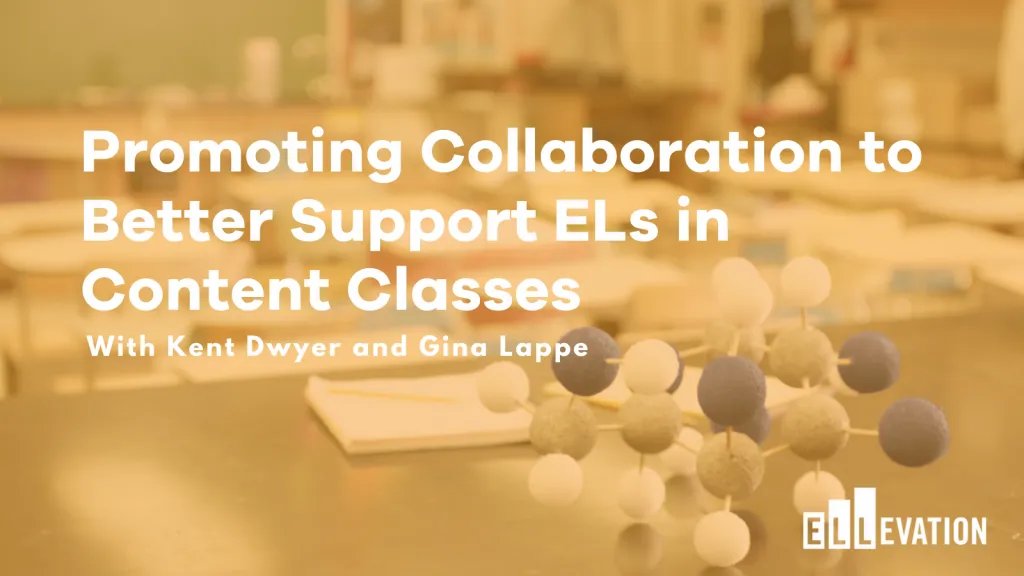Promoting Collaboration to Better Support ELs in Content Classes with Kent Dwyer and Gina Lappe


Promoting Collaboration to Better Support ELs in Content Classes with Kent Dwyer and Gina Lappe
Effective collaboration strategies can have transformative effects on school culture and student outcomes, especially for multilingual learners. Every educator in a school has different strengths, areas of expertise, or resources to share. But what are some effective ways of capitalizing on collaboration and how might we implement systems to support it?
We were recently joined on Highest Aspirations by educators Gina Lappe and Kent Dwyer, who worked together at an international school in South Korea. As the EL Specialist, Kent worked closely with Gina, a science teacher, to implement strategies to support acquisition of academic vocabulary. They discovered that as Gina found success using these scaffolds in her classroom, other content teachers quickly took notice.
In this two-part interview, we hear how Gina and Kent used their partnership to create a school-wide culture of collaboration and build a system to ensure consistency across classrooms and staff. Listen to the full episodes here or wherever you get your podcasts.
If you’re interested in increasing collaboration at your school or even within your own classroom, here are a few initial questions that Gina and Kent address in our conversation.
How can strategic partnerships build eagerness for collaboration at a school?
"In a really content-dense class like science, that isn't always seen as a space where these (scaffolds) fit because there's so much content to cover...but I was finding that content is irrelevant if I wasn't meeting my students' langauge needs." -Gina Lappe
-
Sometimes, it’s not what you hear but who you hear it from. Content teachers (who have plenty on their plates) may feel resistant when a specialist who works with one population asks them to add new scaffolds to their instruction. However, when a content teacher sees another general education teacher using those in practice, they can see how it works in the context of the whole group and may be more motivated to try it.
-
Kent found that when teachers observed ELL strategies being used in Gina’s classroom, they were excited to try them out on their own. Their strategic partnership soon generated a school-wide culture of eagerness for collaboration.
After generating interest, how can you keep momentum going?
-
Once teachers are interested in implementing the scaffolding techniques they’ve observed, it’s important to make any tools or additional resources they will need readily available and easily accessible. Kent shares how they created a Google folder with templates of research-based approaches, lesson plans and work samples, and instructional videos - all searchable within a drive folder by tags and hashtags. Many districts leverage Ellevation Strategies to provide content teachers with research-based, best practice strategies to help them differentiate instruction for multilingual learners.
"After a teacher accesses the materials for a technique, they might decide they're comfortable with trying it independently, or they may want to see it modeled in their classroom to observe it in action. It's a way to provide multiple entry points for teachers the same way we differentiate for our kids." - Kent Dwyer
-
The practice of housing resources that all teachers can access is especially important in cases of high teacher turnover to support alignment and stability across the school’s teaching practices. Once teachers experience the impact of reduced teacher talk and increased student ownership of the language and routines of the classroom, they are much more likely to continue collaborating to support this model.
How can collaboration between students better support multilingual learners and improve classroom culture?
-
Scaffolding for multilingual learners in instruction is a key point of entry; but creating an atmosphere where learning can happen also stems from positive peer interactions. Gina and Kent emphasize the role of collaborative speech as a focal point in student-to-student talk. Students should be regularly partnering up to discuss concepts, improve interpersonal skills and practice building on each other’s ideas.
-
We can help students support one another through creating opportunities to practice mindfulness in the classroom. We discuss the idea of group accountability: if enough students are willing to do what the teacher is asking, this helps with momentum and keeps the class engaged.
During the episode we mention the following resources:
Gina Lappe is heading into her 10th year teaching inquiry-based science. She started teaching in Great Smoky Mountains National Park before heading into the classroom at an Expeditionary Learning Charter School in North Carolina. She currently teaches middle school science at an international school in South Korea. She is passionate about using science as a pathway to get students curious about and connected with the world around them. Please feel free to reach out to Gina via email at ginalappe@gmail.com and Instagram @Lappe_labs.
Kent Dwyer has been an educator for 17 years, focusing primarily on language acquisition. He taught Spanish in Pennsylvania for 11 years, serving as a demonstration teacher at Julia Reynolds Masterman Laboratory and Demonstration School and then as a master teacher at Plymouth Whitemarsh High School. From 2016 to 2021, Kent worked in international education to support English language acquisition, first in Qatar and then in South Korea. Kent has facilitated professional development sessions on topics including digital storytelling for language acquisition, tiered units of instruction, differentiated instruction, interpersonal language use within the classroom, data-driven decision making, integrated performance assessments, and the use of technology to promote communication. He can be reached through his professional instagram at kent.dwyer or via email at kentdwyer13@gmail.com.